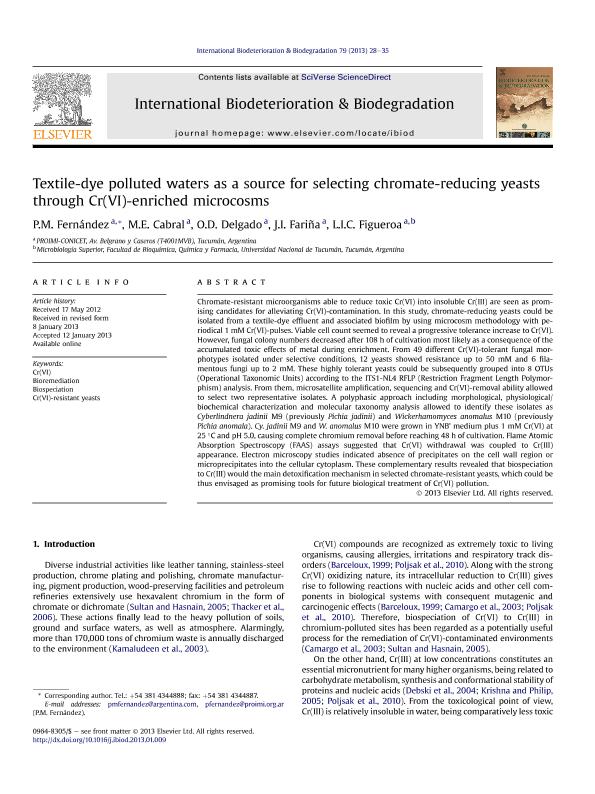Mostrar el registro sencillo del ítem
dc.contributor.author
Fernandez, Pablo Marcelo

dc.contributor.author
Cabral, Maria Eugenia

dc.contributor.author
Delgado, Osvaldo Daniel

dc.contributor.author
Fariña, Julia Inés

dc.contributor.author
Castellanos de Figueroa, Lucia Ines

dc.date.available
2015-08-18T19:27:03Z
dc.date.issued
2013-01
dc.identifier.citation
Fernandez, Pablo Marcelo; Cabral, Maria Eugenia; Delgado, Osvaldo Daniel; Fariña, Julia Inés; Castellanos de Figueroa, Lucia Ines; Textile-dye polluted waters as a source for selecting chromate-reducing yeasts through Cr(VI)-enriched microcosms; Elsevier; International Biodeterioration and Biodegradation; 79; 1-2013; 28-35
dc.identifier.issn
0964-8305
dc.identifier.uri
http://hdl.handle.net/11336/1710
dc.description.abstract
Chromate-resistant microorganisms able to reduce toxic Cr(VI) into insoluble Cr(III) are seen as prom- ising candidates for alleviating Cr(VI)-contamination. In this study, chromate-reducing yeasts could be isolated from a textile-dye effluent and associated biofilm by using microcosm methodology with pe- riodical 1 mM Cr(VI)-pulses. Viable cell count seemed to reveal a progressive tolerance increase to Cr(VI). However, fungal colony numbers decreased after 108 h of cultivation most likely as a consequence of the accumulated toxic effects of metal during enrichment. From 49 different Cr(VI)-tolerant fungal mor- photypes isolated under selective conditions, 12 yeasts showed resistance up to 50 mM and 6 fila- mentous fungi up to 2 mM. These highly tolerant yeasts could be subsequently grouped into 8 OTUs (Operational Taxonomic Units) according to the ITS1-NL4 RFLP (Restriction Fragment Length Polymor- phism) analysis. From them, microsatellite amplification, sequencing and Cr(VI)-removal ability allowed to select two representative isolates. A polyphasic approach including morphological, physiological/ biochemical characterization and molecular taxonomy analysis allowed to identify these isolates as Cyberlindnera jadinii M9 (previously Pichia jadinii) and Wickerhamomyces anomalus M10 (previously Pichia anomala). Cy. jadinii M9 and W. anomalus M10 were grown in YNB’ medium plus 1 mM Cr(VI) at 25 C and pH 5.0, causing complete chromium removal before reaching 48 h of cultivation. Flame Atomic Absorption Spectroscopy (FAAS) assays suggested that Cr(VI) withdrawal was coupled to Cr(III) appearance. Electron microscopy studies indicated absence of precipitates on the cell wall region or microprecipitates into the cellular cytoplasm. These complementary results revealed that biospeciation to Cr(III) would the main detoxification mechanism in selected chromate-resistant yeasts, which could be thus envisaged as promising tools for future biological treatment of Cr(VI) pollution.
dc.format
application/pdf
dc.language.iso
eng
dc.publisher
Elsevier

dc.rights
info:eu-repo/semantics/openAccess
dc.rights.uri
https://creativecommons.org/licenses/by-nc-sa/2.5/ar/
dc.subject
BIOREMEDIATION
dc.subject
BIOSPECIATION
dc.subject
CR(VI)
dc.subject
CR(VI)-RESISTANT YEASTS
dc.subject.classification
Otras Biotecnología del Medio Ambiente

dc.subject.classification
Biotecnología del Medio Ambiente

dc.subject.classification
INGENIERÍAS Y TECNOLOGÍAS

dc.title
Textile-dye polluted waters as a source for selecting chromate-reducing yeasts through Cr(VI)-enriched microcosms
dc.type
info:eu-repo/semantics/article
dc.type
info:ar-repo/semantics/artículo
dc.type
info:eu-repo/semantics/publishedVersion
dc.date.updated
2016-03-30 10:35:44.97925-03
dc.journal.volume
79
dc.journal.pagination
28-35
dc.journal.pais
Países Bajos

dc.journal.ciudad
Amsterdam
dc.description.fil
Fil: Fernandez, Pablo Marcelo. Consejo Nacional de Investigaciones Científicas y Técnicas. Centro Científico Tecnológico Conicet - Tucumán. Planta Piloto de Procesos Industriales Microbiológicos; Argentina
dc.description.fil
Fil: Cabral, Maria Eugenia. Consejo Nacional de Investigaciones Científicas y Técnicas. Centro Científico Tecnológico Conicet - Tucumán. Planta Piloto de Procesos Industriales Microbiológicos; Argentina
dc.description.fil
Fil: Delgado, Osvaldo Daniel. Consejo Nacional de Investigaciones Científicas y Técnicas. Centro Científico Tecnológico Conicet - Tucumán. Planta Piloto de Procesos Industriales Microbiológicos; Argentina
dc.description.fil
Fil: Fariña, Julia Inés. Consejo Nacional de Investigaciones Científicas y Técnicas. Centro Científico Tecnológico Conicet - Tucumán. Planta Piloto de Procesos Industriales Microbiológicos; Argentina
dc.description.fil
Fil: Castellanos de Figueroa, Lucia Ines. Universidad Nacional de Tucuman. Facultad de Bioquimica, Quimica y Farmacia; Argentina. Consejo Nacional de Investigaciones Científicas y Técnicas. Centro Científico Tecnológico Conicet - Tucumán. Planta Piloto de Procesos Industriales Microbiológicos; Argentina
dc.journal.title
International Biodeterioration and Biodegradation

dc.relation.alternativeid
info:eu-repo/semantics/altIdentifier/doi/http://dx.doi.org/10.1016/j.ibiod.2013.01.009
dc.relation.alternativeid
info:eu-repo/semantics/altIdentifier/url/http://www.sciencedirect.com/science/article/pii/S0964830513000115
Archivos asociados
